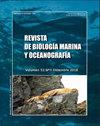Análisis bioinformático del sistema flagelar de la alphaproteobacteria tipo rickettsia Candidatus Hepatobacter penaei
IF 0.5
4区 生物学
Q4 MARINE & FRESHWATER BIOLOGY
引用次数: 1
Abstract
The presence of flagellar systems is common in several free-living bacteria; however, these have been considered absent in bacteria belonging to the Rickettsiales order. Candidatus Hepatobacter penaei is a marine Rickettsial bacterium described as a motile microorganism propelled by a flagellar system that facilitates infection. This bacterium represents a major risk of infection in shrimp farms. Therefore, the objective of this study was to determine the presence of genes encoding the flagellar system proteins of the bacterium Candidatus Hepatobacter penaei. The genomic sequence of the GenBank database with accession number NZ_JQAJ00000000.1, was analyzed. After genes were identified, amino acid sequences were deduced. The amino acid sequences of the flagellar system were identified by BLASTP through multiple alignment of conserved domains. Subsequently, a modeling process of FlhA protein was performed and compared with the protein reported for Oceanibaculum indicum considering the formation of -helixes and -sheets. Results showed the presence of some amino acid sequences of the genes related to bacterial flagellar system as MotA FliG, FliN, FliL FlhA, FlhB, FliQ FliR and FliF. Finally, these results suggest that Candidatus Hepatobacter penaei is a rickettsial bacterium having a flagellar system, which possibly confers motility and take part in the infection process in hosts such as marine crustaceans.拟立克次体肝杆菌鞭毛系统的生物信息学分析
鞭毛系统的存在在一些自由生活的细菌中是常见的;然而,这些被认为在属于立克次体目的细菌中不存在。penaei候选肝杆菌是一种海洋立克次体细菌,被描述为一种由鞭毛系统推动的运动微生物,促进感染。这种细菌是虾养殖场感染的主要风险。因此,本研究的目的是确定penaei候选肝杆菌鞭毛系统蛋白编码基因的存在。分析GenBank数据库的基因组序列,登录号为nz_jqaj000000001。基因鉴定后,推导出氨基酸序列。利用BLASTP技术,通过保守结构域的多次比对,鉴定了鞭毛系统的氨基酸序列。随后,进行了FlhA蛋白的建模过程,并将其与已报道的Oceanibaculum indicum蛋白进行了比较,考虑了-螺旋和-sheet的形成。结果表明,细菌鞭毛系统相关基因中存在MotA FliG、FliN、FliL FlhA、FlhB、FliQ FliR和FliF等氨基酸序列。最后,这些结果表明,penaei候选肝杆菌是一种具有鞭毛系统的立克次体细菌,它可能赋予运动性并参与宿主(如海洋甲壳类动物)的感染过程。
本文章由计算机程序翻译,如有差异,请以英文原文为准。
求助全文
约1分钟内获得全文
求助全文
来源期刊
CiteScore
0.70
自引率
0.00%
发文量
41
审稿时长
12 months
期刊介绍:
Publicar desde una perspectiva científica, artículos originales, decididos por un proceso de revisión por pares, invitando a expertos de reconocido prestigio en el área. Los trabajos publicados se caracterizarán por su solidez teórica-metodológica, actualidad y relevancia para las ciencias marinas.
Se reciben trabajos inéditos derivados de la investigación científica realizada en ambientes marinos y estuarios, en formato de Revisión, Artículos, Notas Científicas, y Obituarios en las siguientes disciplinas::
Biología-Ecología marina
Oceanografía física, química y biológica
Contaminación marina
Geología marina
Sistemática, Faunística y Biogeografía Marina
Manejo Costero
Acuicultura marina
Pesquería marina.

 求助内容:
求助内容: 应助结果提醒方式:
应助结果提醒方式:


